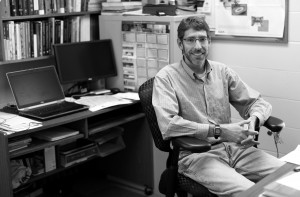Concordia professors still involved in activities they were a part of in college

The Concordia community has numerous athletic groups. Aside from the student body, which makes up more than half of the campus’ athletic unit, a number of the faculty and staff also participate in sporting events. Although not all members of Concordia’s athletic community do not compete in the collegiate events, they enjoy taking part in the fun.
Senior Kayla Koppendrayer, an exercise advocate, is excited to learn that different groups of people in the Concordia community have found a way to stay occupied through athletics. Koppendrayer believes in the functional importance of the athletic involvement.
“It’s good to have that on top of doing school work because it keeps you healthy in your mind,” Koppendrayer said.
Since before joining the Concordia community, mathematics professor Dr. Doug Anderson took part in competitive sports. During his undergraduate studies at Augustana College, Anderson was a Division II cross-country and track runner.
“I liked to run; I was pretty good at it,” Anderson said. “It was fun to have teammates and train together because it’s hard to train alone. Yeah, and it gave me a break from studying every day.”
Anderson played continually throughout his four years at Augustana. He went on to graduate school but kept running after college for recreational purposes. However, according to the former cross-country and track runner, running was no longer a sustainable method for him to stay active.
“Probably around 2000 or so, I got hurt and it seemed to be connected to the way that I run, the form that I have,” Anderson said. “And rather than change my form, I just quit and took up cycling.”
With running off the table, Anderson, a forefoot striker, turned to cycling because it did not require him to change his running form. According to Anderson, back when there was a biking club at Concordia, he was the faculty advisor of the group for two years.
“There was a cycling club for a long time, especially (in) the 70’s,” Anderson said. “Over fall break they would go from Moorhead to Duluth, and they would take the whole fall break to do that.”
The lack of a biking group or a strenuous running form does not stop Dr. Anderson from being physically active now. Even during the colder seasons, he believes there are still ways to move around. Anderson explained that for a mathematician like him, the effort to stay active goes beyond physical fitness as it can benefit problem solving skills.
“It takes your conscious mind off that problem, and then sometimes you can solve something while you’re enjoying the physical exercise,” Anderson said. “Mathematicians are well known to like climbing, hiking, cycling, walking, running; just because of that.”
There are other benefits that different members of Concordia’s community enjoy from being involved in sports. Dining Services staff member and MSUM student, Trevor Stevens, put aside time during his week to participate in Casselton’s and Fargo’s basketball city leagues. According to Stevens, basketball was a more accessible activity to participate in.
“It’s just getting out there and doing what I like to do,” Stevens said. “I am pretty tall, six-ten. People always wanted me to play basketball and I grew up with it.”
Stevens also grew up playing tennis, but in addition to the sport being less popular, it also became an expensive activity to keep up. According to Stevens the costs of tennis add up fast for someone who makes a commitment to stick with the sport for fun. Between maintenance and participation fees, it became harder to play tennis compared to basketball.
“Rackets are like three hundred bucks, and you can’t just buy one; you usually [have to] buy three at a time” Stevens said. “Say you are in the middle of a match … you break a string; you usually have to have a backup that’s identical to the one you’re using so it doesn’t mess you up.”
With the amount of logistics that go into maintaining a consistent tennis hobby, the expenses can add up quickly. In the basketball city league, Stevens still has to pay to be on a team for a season. According to the recreational basketball player, the cost of playing basketball throughout a traditional winter season is more manageable compared to the price of tennis equipment.
For all these individuals, sports are a way to recharge, stay active and be productive. Whether it is the talented student or the activity seeking individual, athletes present themselves in different forms and seek to have various motivation to participate in their respective sports. According to Dr. Anderson, there is value to him being able to move outside on a bike.
“I still enjoying biking a lot while I can,” Anderson said. “And in the summer the same way, I work on math and then go outside and cycle a lot.”

